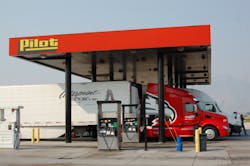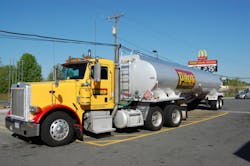Fuel prices still rising, despite low oil price forecast
Fuel prices continued to rise sharply this week across the U.S., according to data tracked by the Energy Information Administration (EIA), though the agency still expects oil prices to remain relatively low over the next two years, hovering between $34 and $40 per barrel in 2016 and 2017, respectively.
Diesel fuel climbed 7.8 cents to a U.S. average retail pump price of $2.099 per gallon, EIA reported, though that is 81.8 cents per gallon cheaper compared to the same week in 2015.
Diesel prices jumped the most this week in the lower Atlantic region, increasing 9.1 cents to $2.070 per gallon, while prices remained below the $2 per gallon mark only in the Gulf Coast and Rocky Mountain regions – albeit barely – at $1.990 and $1.999 per gallon, respectively.
Average U.S. retail pump prices for gasoline climbed 12 cents to $1.961 per gallon, though that is 49.2 cents per gallon cheaper compared to the same week last year, EIA said.Gasoline prices remained below the $2 per gallon mark in all regions of the country except for the West Coast, where gasoline costs a retail average of $2.394 per gallon, which drops to $2.045 per gallon with California’s prices removed from the mix.
Despite the recent spike in fuel prices, EIA continues to forecast relatively low oil prices for the next years. According to its Short-Term Energy Outlook (STEO) released last week, the agency projects that North Sea Brent crude oil prices will average $34 per barrel in 2016 and $40 per barrel in 2017, $3 and $10 per barrel lower, respectively, than projections made back in February.
EIA also expects that West Texas Intermediate (WTI) prices will average about the same as the Brent marker in 2016 and 2017.
“The lowering of the price forecast in the current STEO reflects oil production that has been more resilient than expected in a low-price environment and reduced expectations for oil demand growth,” EIA noted in its report. “The resulting inventory builds are larger than previously expected throughout the forecast period, thus delaying the expected rebalancing of the oil market and contributing to lower forecast oil prices.”
The agency added that those increased inventory builds are a major source of uncertainty in its price forecast.
“If global storage capacity becomes stressed, the cost of storage will rise to reflect more expensive marginal storage options such as floating inventories on crude oil tankers,” EIA noted. “Higher storage costs would tend to divert volumes that would otherwise be stored into the spot market, reducing near-month crude oil prices. Additional uncertainty stems from the pace of global economic growth and its contribution to oil demand growth, and the responsiveness of non-OPEC producers to sustained low oil prices.”
Additionally, lower expectations for global economic growth are contributing to the agency’s reduction in the oil demand forecast.
EIA expects global consumption of petroleum and other liquid fuels to grow by 1.1 million barrels per day (B/d) in 2016 and by 1.2 million b/d in 2017.
Forecast consumption is 0.1 million b/d and 0.2 million b/d lower in 2016 and 2017, respectively, than in last month’s STEO because of lower expected growth in real gross domestic product (GDP) for the world weighted by oil consumption, the agency said.
After rising by 2.4% in 2015, forecast real GDP weighted by oil consumption rises by 2.3% in 2016 and by 3.0% in 2017. In the February STEO, growth was forecast at 2.6% in 2016 and 3.1% in 2017, EIA noted.
About the Author
Sean Kilcarr
Editor in Chief
Sean Kilcarr is a former longtime FleetOwner senior editor who wrote for the publication from 2000 to 2018. He served as editor-in-chief from 2017 to 2018.

